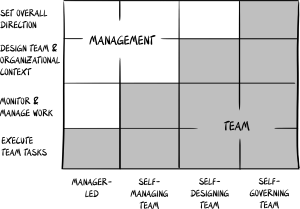Hackman Authority Matrix

The Hackman Authority Matrix, developed by organizational psychologist John Richard Hackman, is a framework used to understand different levels of team autonomy and the skills required for effective self-organization. It categorizes teams into four types based on their level of self-governance:
-
Manager-led teams - Traditional teams where the manager directs tasks and team members have limited autonomy.
-
Self-leading teams - Teams that manage their work and outcomes with more responsibility and less direct oversight.
-
Self-designing teams - Groups that set their own frameworks and processes, possibly extending to personnel decisions.
-
Autonomous teams - Teams with complete freedom over their work and goals, often found in boardrooms and startups.
This matrix helps organizations transition from manager-led to fully autonomous teams by clarifying the roles, responsibilities, and skills needed at each level. It emphasizes the importance of gradually acquiring the necessary competencies for self-organization to minimize chaos and enhance agile collaboration.
In Agile frameworks, such as Scrum, this model is especially relevant. It provides a clear pathway for teams to grow their capabilities in self-management by defining stages from manager-led to self-leading, self-designing, and finally, to autonomous teams. The gradual increase in responsibility and authority at each level helps teams to incrementally acquire the necessary skills for self-organization, thus facilitating smoother transitions and more effective collaboration.
The main benefit of understanding and applying the Hackman Authority Matrix in an Agile setting is to foster a structured approach to developing self-organization within teams. This approach aligns with Agile principles of iterative improvement and flexibility, allowing teams to adapt and evolve their processes and interactions to better meet project demands and enhance productivity.

Hackman Model on Team Effectiveness
Additionally, you can learn from our Certified Scrum Trainer, Sohrab Salimi, more about Hackman and his Model on Team effectiveness in this video from our self-paced online courses.